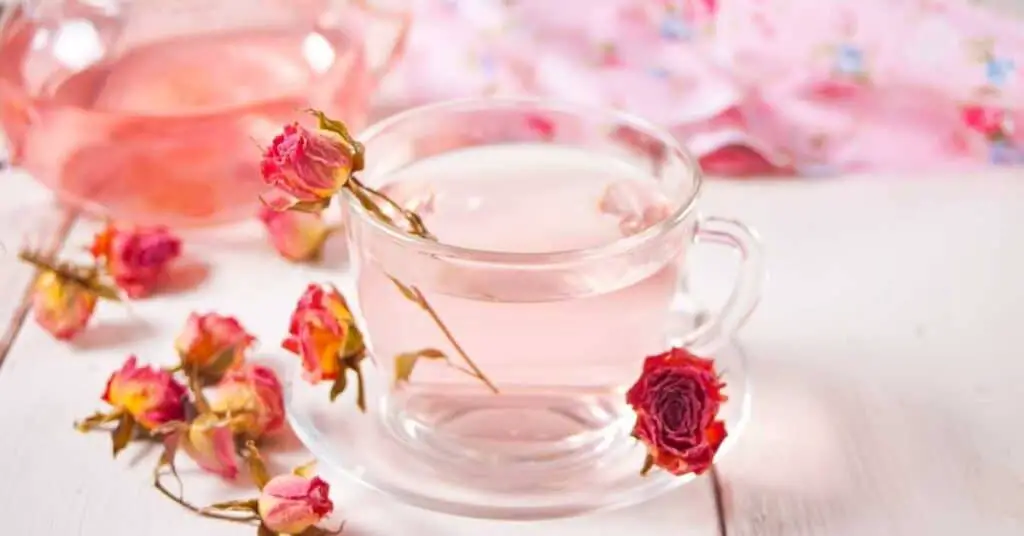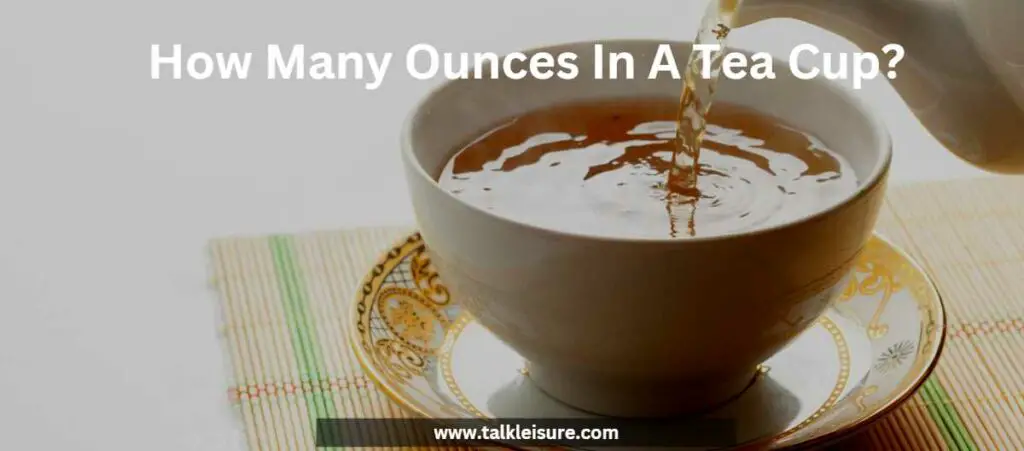Step into a world where tea isn’t just a beverage but a cherished tradition steeped in history and enriched by cultural significance.
Moroccan Mint Tea, a symphony of green tea leaves and fresh mint, beckons with its enchanting aroma and captivating flavors.
This ancient ritual, dating back to the 18th century, is more than a simple brew; it’s a gesture of warmth, a symbol of hospitality, and a cornerstone of Moroccan social gatherings.
Join us as we embark on a journey through the art, history, and global influence of Moroccan Mint Tea, uncovering the magic that lies within each fragrant cup.
Also read: A journey through Japan’s traditional tea ceremonies.
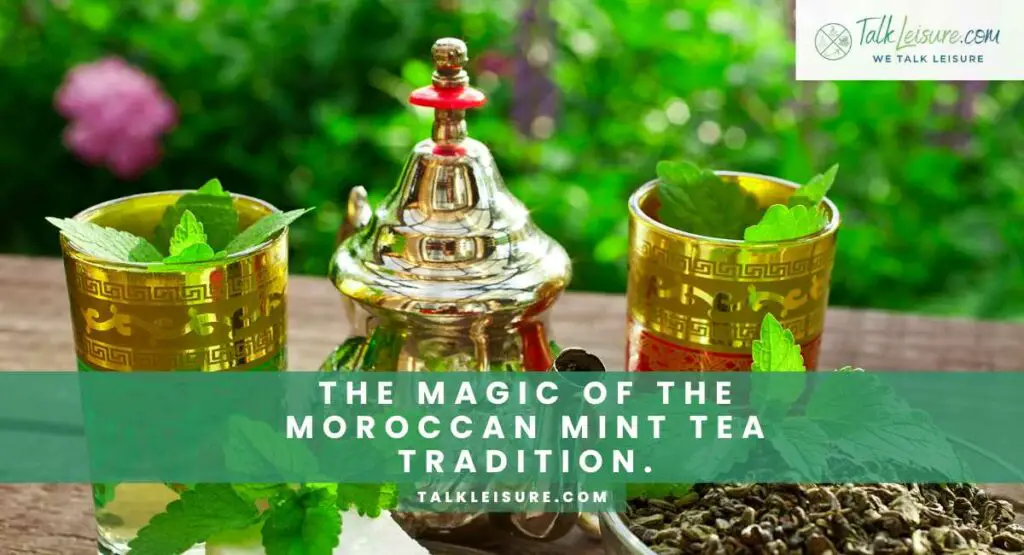
Unwrapping the Mystique of Moroccan Mint Tea
Hey there, tea enthusiasts and curious minds alike! Today, we’re about to embark on a journey that’s as enchanting as the ancient streets of Marrakech and as refreshing as a mountain breeze in the Atlas Mountains. We’re going to unlock the secrets behind one of the world’s most cherished tea traditions: Moroccan Mint Tea.
Picture this: sun-drenched courtyards, vibrant markets, and the tantalizing aroma of fresh mint leaves dancing in the air. That’s the essence of Moroccan Mint Tea – a brew that’s more than just a beverage; it’s an experience steeped in history, culture, and a generous sprinkle of hospitality.
Discovering Moroccan Mint Tea: A Cultural Odyssey
This isn’t just about a cup of tea; it’s a window into Moroccan heritage. For generations, Moroccan families have gathered around pots of simmering tea, passing down the art of preparation like a treasured heirloom. It’s a ritual that transcends generations, weaving tales of warmth, connection, and the unmistakable magic of mint-infused green tea.
As we delve deeper, you’ll learn about the delicate dance between green tea leaves and vibrant mint, a combination that brings together earthy richness and a burst of invigorating freshness. It’s this harmonious blend that sets Moroccan Mint Tea apart, making it a sensory delight for the soul.
Time-Tested Tradition: Moroccan Mint Tea’s Historical Roots
To truly appreciate the magic, we must venture into the annals of history. This tradition, believed to have originated in the 18th century, has its roots in the ancient trade routes that crisscrossed Morocco. With merchants carrying prized bundles of tea leaves from distant lands, the foundation was laid for what would become a cornerstone of Moroccan culture.
Through the ages, Moroccan Mint Tea has evolved, shaped by the hands of countless tea masters and cherished by communities spanning the length and breadth of this captivating North African nation. Each sip carries with it the echoes of centuries past, making it a living, breathing testament to the enduring power of tradition.
So, dear reader, fasten your seatbelt, because we’re about to embark on a journey that will transport you to the heart of Moroccan culture, one aromatic cup at a time.
Get ready to learn the art, feel the history, and taste the magic of Moroccan Mint Tea like never before. Let’s brew some memories!
Also read: The delightful world of tea-infused desserts and pastries.
Ingredients for a Perfect Pot of Moroccan Mint Tea
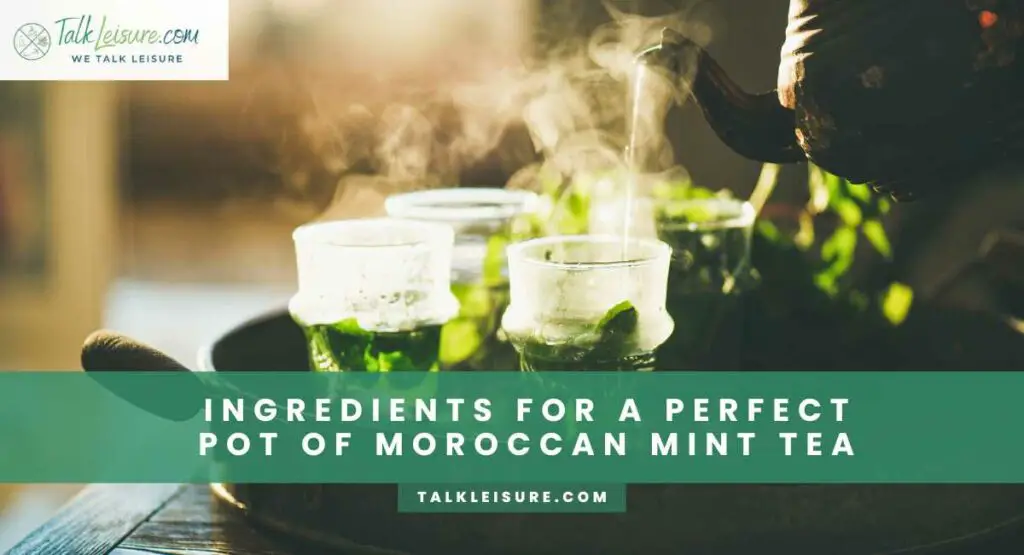
Welcome back, fellow tea enthusiasts! Now that we’ve dipped our toes into the rich history and culture of Moroccan Mint Tea, it’s time to roll up our sleeves and get into the nitty-gritty of what makes this brew truly special: the ingredients.
1. Green Tea Leaves: The Heart of the Brew
At the core of Moroccan Mint Tea lies the humble green tea leaf. This isn’t just any tea, mind you. It’s a special variety, carefully selected for its robust flavor and ability to harmonize with the fresh burst of mint. High-quality loose-leaf green tea is the gold standard here, but if you’re in a pinch, a good-quality green tea bag can certainly do the trick.
2. Fresh Mint Leaves: The Soul of the Infusion
Now, let’s talk about the star of the show: mint. Freshness is key. Imagine plucking sprigs of vibrant mint straight from a Moroccan garden. That’s the level of freshness we’re aiming for. Spearmint is the go-to variety, although some adventurous souls might opt for peppermint for a slightly spicier kick. It’s this minty symphony that elevates the tea to a whole new level.
3. Sugar (Optional): Sweetening the Deal
Here’s where we enter the realm of personal preference. While traditionally Moroccan Mint Tea isn’t excessively sweetened, a touch of sugar can enhance the overall experience. The sweetness plays a subtle supporting role, allowing the flavors of the tea and mint to shine without overpowering them. Of course, you can adjust this to your liking – some prefer a gentle hint of sweetness, while others might opt for a more robust sugary embrace.
4. Boiling Water: The Catalyst of Infusion
Water is the canvas upon which this masterpiece is painted. It should be fresh and brought to a rolling boil. This ensures that it extracts the full essence of both the green tea leaves and the mint leaves. The perfect brew requires the perfect temperature, and boiling water is the ticket to unlocking the full potential of these ingredients.
With these components in hand, you’re armed and ready to embark on the journey of creating a pot of Moroccan Mint Tea that’ll transport you straight to the bustling medinas of Morocco.
In the next section, we’ll explore the art of preparation, where we’ll bring these elements together in a symphony of flavor. Stay tuned, because the magic is about to unfold!
Also read: The art and science of tea aging: Exploring vintage teas.
The Art of Preparation: Crafting the Perfect Brew
Alright, tea aficionados, now that we have our ingredients ready, it’s time to delve into the heart of the matter: the meticulous process of preparing Moroccan Mint Tea. This is where the magic truly happens, where simple leaves and hot water transform into a concoction that will tantalize your taste buds and soothe your soul.
1. Choosing the Right Teapot: A Vessel for Tradition
The vessel you choose to brew your Moroccan Mint Tea is more than just a container; it’s a tribute to tradition. Opt for a sturdy, heat-resistant teapot. The classic Moroccan teapot, known as a “teyan,” is a work of art in itself. Its distinctive shape and intricate design not only aid in the brewing process but also add an authentic touch to the experience.
2. Proper Brewing Techniques: Timing is Everything
This is where precision comes into play. Begin by placing the green tea leaves in the teapot. For every teaspoon of green tea, add a sprig or two of fresh mint leaves. This delicate dance of ratios ensures a harmonious blend of flavors. Now, pour the boiling water over the leaves, allowing them to mingle and infuse their essence into the water.
3. Infusion Time: Patience, Grasshopper
The key here is patience. Let the tea steep for about 3–5 minutes. This allows the flavors to intermingle and reach their full potential. You’ll witness the water transform into a mesmerizing amber hue, a sign that the alchemy of flavors is well underway.
4. The Pouring Ceremony: Elegance in Motion
Ah, now comes the graceful finale. Moroccan Mint Tea is traditionally poured from a height, a skill that’s perfected over time. This aerates the tea, enhancing its aroma and creating a beautiful, frothy layer on top. It’s not just about the taste; it’s about the sensory experience that comes with each pour.
With this careful preparation, you’re on the brink of experiencing Moroccan Mint Tea in its truest form. In the next section, we’ll explore the ceremonial aspects and the role this tea plays in Moroccan social gatherings.
Get ready to immerse yourself in the traditions and etiquette surrounding this age-old ritual. The journey continues!
Ceremonial Aspects: Tea as a Symbol of Hospitality

Greetings, fellow tea enthusiasts! As we’ve delved into the art of Moroccan Mint Tea preparation, it’s time to unveil the ceremonial aspects that make this tradition so captivating. In Morocco, tea isn’t just a beverage; it’s a gesture of warmth, a symbol of hospitality, and a cornerstone of social interaction.
1. Tea as a Gesture of Welcome and Hospitality
When you step into a Moroccan home, you’re likely to be greeted with a warm smile and a pot of freshly brewed Moroccan Mint Tea. It’s a gesture that transcends language, a universal sign of welcome that instantly makes you feel at home. The act of serving tea is a genuine expression of hospitality, a way of saying, “You’re not just a guest; you’re family.”
2. Rituals and Etiquette: A Dance of Respect
There’s an elegant choreography that accompanies the serving of Moroccan Mint Tea. The host takes on the role of the “mcha” or the pourer, while the guests watch in anticipation. The first pour is always discarded, a gesture of respect for the guest. Subsequent pours are offered with a graceful, sweeping motion, ensuring that each cup is filled to perfection.
3. Traditional Serving Ware: A Feast for the Eyes
The vessels used to serve Moroccan Mint Tea are a testament to the country’s rich artisanal heritage. The tea is typically poured from a beautifully adorned teapot into small, intricately designed glasses. These glasses, known as “glasses of tea,” are often embellished with colorful patterns, adding a touch of elegance to the ceremony.
As you sip on your cup of Moroccan Mint Tea, you’re not just indulging in a delicious brew; you’re participating in a time-honored tradition that has been passed down through generations. It’s an experience that goes beyond taste, inviting you to be a part of Moroccan culture and hospitality.
In our next section, we’ll explore the health benefits of this delightful infusion.
Get ready to discover how Moroccan Mint Tea doesn’t just please the palate, but also nurtures the body and soul. Stay tuned!
The Health Benefits of Moroccan Mint Tea
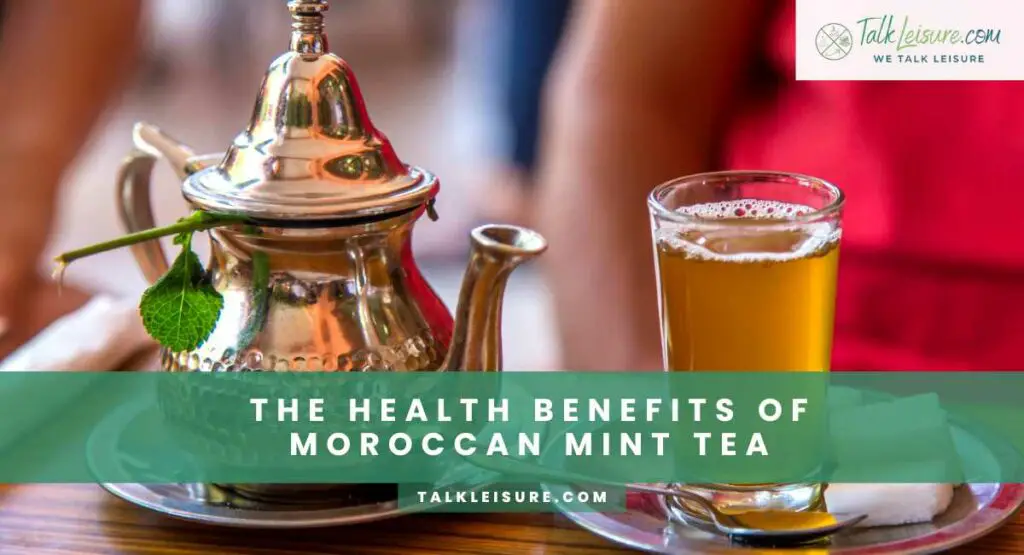
Greetings, health-conscious readers! Now that we’ve unraveled the cultural tapestry surrounding Moroccan Mint Tea, it’s time to turn our attention to the myriad of health benefits that this aromatic infusion brings to the table. Beyond its delightful flavor, Moroccan Mint Tea packs a powerful punch of wellness.
1. Digestive Properties of Mint: A Soothing Elixir
Mint has long been celebrated for its digestive properties. Sipping on Moroccan Mint Tea after a meal can aid in digestion, alleviating discomfort and bloating. The natural oils in mint stimulate the digestive enzymes, helping food to pass through the digestive tract with ease.
2. Antioxidant Richness of Green Tea: A Potion for Vitality
Green tea, one of the primary ingredients in Moroccan Mint Tea, is a treasure trove of antioxidants. These powerful compounds help combat oxidative stress in the body, protecting cells from damage and bolstering overall health. Regular consumption of green tea has been associated with a reduced risk of chronic diseases.
3. Stress Relief and Relaxation: A Calming Cup
Life can be hectic, and finding moments of calm is essential. Moroccan Mint Tea offers a soothing respite. The combination of green tea and mint works wonders in calming the nerves and promoting relaxation. It’s a gentle invitation to unwind, sip by sip.
4. Refreshing Hydration: Nourishment for the Body
Staying hydrated is vital for overall well-being, and Moroccan Mint Tea provides a flavorful way to achieve this. The combination of green tea and mint ensures that you not only quench your thirst but also infuse your body with essential nutrients and hydration.
5. A Boost to the Immune System: Nature’s Shield
Both green tea and mint are known to have immune-boosting properties. They contain compounds that enhance the body’s natural defense mechanisms, helping to ward off illnesses and keeping you feeling your best.
By incorporating Moroccan Mint Tea into your routine, you’re not only treating your taste buds to a delightful experience but also gifting your body a dose of natural wellness. It’s a true testament to the holistic benefits that can be derived from a simple cup of tea.
In our next section, we’ll explore the various variations and customizations that allow you to tailor this tradition to your unique taste. Stay tuned!
Variations and Customizations: Tailoring Your Tea Experience

Greetings, adventurous tea enthusiasts! Now that we’ve established the numerous health benefits of Moroccan Mint Tea, let’s venture into the realm of creativity and personalization. This is where you get to put your own spin on this time-honored tradition.
1. Different Flavor Profiles: Beyond Mint and Green Tea
While the classic combination of green tea and fresh mint leaves forms the cornerstone of Moroccan Mint Tea, there’s a world of possibilities waiting to be explored. Consider infusing your brew with a splash of lemon for a zesty twist, or try incorporating orange blossom for a fragrant, citrusy note. These variations add layers of complexity to the flavor profile, allowing you to tailor the tea to your unique taste.
2. Adjusting Sweetness to Personal Preference
Sweetness is a subjective affair, and Moroccan Mint Tea is no stranger to customization in this department. Some prefer a gentle hint of sweetness, achieved through a modest addition of sugar. Others might opt for a more robust sugary embrace, creating a dessert-like indulgence. The beauty of this tradition lies in its adaptability to your individual palate.
3. Infusing Other Herbs and Spices: A Spice Bazaar of Possibilities
Why stop at mint? The world of herbs and spices is at your disposal. Experiment with additions like cinnamon sticks, ginger, or even a touch of cardamom for a unique twist. These additions not only contribute to the flavor profile but also bring their own set of health benefits, elevating your tea experience to new heights.
4. Exploring Tea Blends: A Symphony of Flavors
Moroccan Mint Tea is a versatile canvas, and it plays well with a variety of tea blends. Consider experimenting with different types of green teas, each with its own nuanced flavor profile. Sencha, Gunpowder, or Dragon Well – the possibilities are endless. Each blend brings its own character to the brew, allowing you to curate a tea experience that’s uniquely yours.
By embracing these variations and customizations, you’re not just making tea; you’re crafting a sensory experience tailored to your taste and preferences.
In our next section, we’ll embark on a global journey to discover how Moroccan Mint Tea has influenced international cuisine. Stay tuned, because the adventure is just beginning!
The Global Influence and Popularity of Moroccan Mint Tea
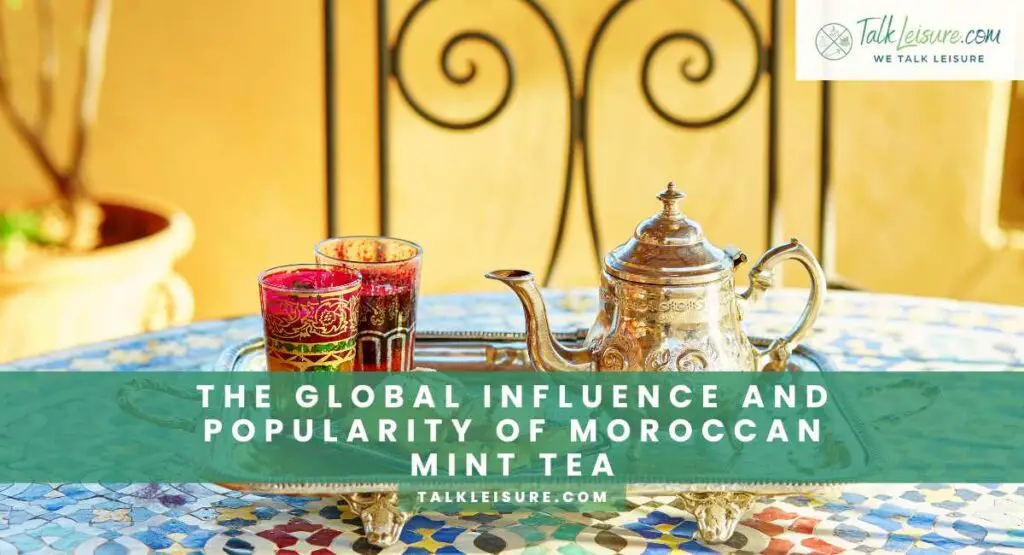
Greetings, curious travelers of taste! As we’ve explored the art and science of Moroccan Mint Tea, it’s time to embark on a journey beyond the borders of Morocco. This humble brew has transcended cultural boundaries, making its mark on international cuisine and captivating palates worldwide.
1. Moroccan Mint Tea in International Cuisine: A Culinary Affair
The allure of Moroccan Mint Tea knows no bounds. It has found its way into the hearts and menus of restaurants and cafes around the globe. From the bustling streets of New York to the quaint tea houses of Paris, you’re likely to find a steaming pot of Moroccan Mint Tea waiting to transport you to the bustling markets of Marrakech.
2. Contemporary Adaptations: Fusion Flavors
As with any culinary tradition, Moroccan Mint Tea has evolved over time. Chefs and tea enthusiasts alike have taken inspiration from this age-old tradition, infusing it with their own creative flair. You might stumble upon variations that incorporate exotic fruits, aromatic herbs, or even a splash of spirits for a modern twist on this classic brew.
3. The Social Experience: Bringing People Together
Much like in Morocco, sharing a pot of Moroccan Mint Tea has become a social ritual in many parts of the world. It’s a catalyst for conversation, a reason to gather, and a shared experience that transcends cultural differences. In a world that’s often fast-paced and disconnected, the act of sitting down with a cup of tea can be a powerful reminder of our shared humanity.
4. Moroccan Mint Tea in Wellness Circles: Mindful Sipping
The health benefits of Moroccan Mint Tea have not gone unnoticed in the global wellness community. It has found a place among mindful sippers seeking a natural way to relax, rejuvenate, and reap the benefits of antioxidants and digestive aids.
By tracing the global influence of Moroccan Mint Tea, we see how this tradition has touched hearts and palates across continents. Its adaptability and universal appeal are a testament to the enduring magic of this enchanting brew.
Recipe for Authentic Moroccan Mint Tea

Greetings, tea enthusiasts and aspiring tea maestros! Now that we’ve uncovered the cultural richness and global influence of Moroccan Mint Tea, it’s time to roll up our sleeves and create this delightful brew in the comfort of your own home. Follow this step-by-step recipe to capture the essence of this cherished tradition.
Ingredients:
- 1 tablespoon loose-leaf green tea or 2 green tea bags
- A handful of fresh mint leaves (about 10-12 sprigs)
- Sugar to taste (optional)
- 4 cups of boiling water
Instructions:
- Select Your Tea: If using loose-leaf green tea, measure out one tablespoon. If using tea bags, use two for a stronger infusion.
- Embrace Freshness: Pluck the mint leaves, ensuring they’re fresh and vibrant. Rinse them gently to remove any dust or impurities.
- Preheat Your Teapot: Pour a small amount of boiling water into your teapot, swish it around, and then discard. This warms the pot, ensuring that your tea brews at the perfect temperature.
- The Minty Embrace: Place the green tea leaves or tea bags into the preheated teapot. Add the fresh mint leaves on top.
- Boiling Water Magic: Carefully pour the boiling water over the tea leaves and mint. This is where the magic begins!
- Steep with Patience: Place the lid on the teapot and let the tea steep for 3-5 minutes. This allows the flavors to meld and the aroma to intensify.
- Sweeten the Deal (Optional): If you prefer your tea sweet, this is the time to add sugar to taste. Start with a small amount and adjust to your liking.
- The Pouring Ceremony: Hold the teapot high and pour the tea into small glasses in one smooth, continuous motion. This aerates the tea, creating a frothy layer on top.
- Savor the Moment: Lift the glass to your lips and take in the aromatic steam. Sip slowly, allowing the flavors to dance on your palate.
Congratulations! You’ve just brewed a pot of authentic Moroccan Mint Tea. Feel free to adjust the ratios and sweetening to suit your taste preferences. Now, find your favorite spot, perhaps with a good book or a dear friend, and savor the magic of this ancient tradition right in your own home. Enjoy!
Conclusion: Savoring the Magic of Moroccan Mint Tea
In every fragrant sip, Moroccan Mint Tea reveals its centuries-old tale of tradition, warmth, and hospitality. From the bustling markets of Marrakech to cozy corners around the world, this brew transcends borders, uniting hearts over a shared pot.
With a touch of green tea, a handful of fresh mint, and a sprinkle of hospitality, you’ve embarked on a journey that captures the essence of Morocco. Whether in a bustling cafe or the comfort of your own home, may each cup be a reminder of the enduring magic woven into this cherished tradition. Here’s to savoring the art and soul of Moroccan Mint Tea, one delightful sip at a time.
Frequently Asked Questions
- Why do Moroccans pour mint tea high?
Pouring Moroccan Mint Tea from a height serves both functional and ceremonial purposes:
- Aeration and Frothiness: Pouring the tea from a height allows it to aerate as it flows into the glass. This introduces oxygen, which can enhance the flavor and aroma. Additionally, it creates a frothy layer on top of the tea, adding to the visual appeal.
- Mixing and Blending: Pouring from a height helps to mix the tea thoroughly. This ensures that the flavors of the green tea and mint are well-distributed, creating a balanced and harmonious taste.
- Cultural Significance: The pouring of tea in Morocco is a ceremonial act, steeped in tradition and etiquette. It’s considered a sign of respect and hospitality. The higher the pour, the more skill and experience it demonstrates, showcasing the host’s expertise in preparing and serving tea.
Overall, the act of pouring Moroccan Mint Tea from a height is a beautiful and symbolic element of the tea-drinking experience, adding to the overall enjoyment and appreciation of this cherished tradition.
- What is the disadvantage of mint tea?
While mint tea offers numerous benefits, there are a few potential disadvantages to consider:
- Acid Reflux or Heartburn: For some individuals, particularly those with acid reflux or heartburn, consuming mint tea may exacerbate these conditions. Mint can relax the lower esophageal sphincter, potentially allowing stomach acid to flow back up into the esophagus.
- Interference with Iron Absorption: Some studies suggest that excessive consumption of mint tea may interfere with the absorption of iron, especially when consumed with meals. This could potentially be problematic for individuals with iron-deficiency anemia.
- Allergic Reactions: While rare, some individuals may be allergic to mint. Allergic reactions can range from mild symptoms like skin irritation to more severe reactions requiring medical attention.
- Gastrointestinal Issues: In some cases, excessive consumption of mint tea, particularly in high concentrations, may lead to digestive discomfort or upset stomach.
- Interaction with Medications: Mint may interact with certain medications. It’s advised to consult with a healthcare professional if you’re taking medications regularly.
- For Breastfeeding Women: While mint tea can be consumed in moderation, it’s recommended that breastfeeding mothers limit their intake as large amounts of mint may potentially affect milk supply.
It’s important to note that these potential disadvantages are generally associated with excessive consumption of mint tea. When consumed in moderation, as part of a balanced diet, mint tea can be enjoyed safely by most individuals. As with any dietary element, it’s wise to consult with a healthcare professional if you have specific concerns or medical conditions.
- Is it OK to drink mint tea every day?
Yes, it is generally safe to enjoy mint tea daily in moderation. It offers various health benefits, including aiding digestion and providing antioxidants. However, excessive consumption may lead to digestive discomfort for some individuals. If you have specific health concerns, consult with a healthcare professional before making it a regular part of your diet.

